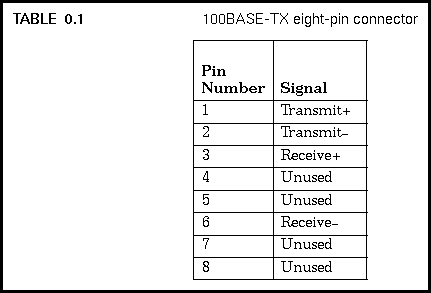The 100BASE-TX media system uses two pairs of wires, which means that four pins of the eight-pin (RJ-45 style) MDI connector are used to carry Ethernet signals. 
The transmit and receive data signals on each pair of a 100BASE-TX segment are polarized, with one wire of each signal pair carrying the positive (+) signal, and the other carrying the negative (-) signal.
The pin numbers used in the eight-pin connector for 100BASE-TX were changed from the ones defined in the ANSI TP-PMD standard, in order to conform to the wiring scheme already in use in the 10BASE-T standard. The ANSI standard uses pins 7 and 8 for receive data, whereas 100BASE-TX uses the same pins as the 10BASE-T system: 3 and 6. That way, a 100BASE-TX board can replace a 10BASE-T board, and be plugged into the same Category 5 wiring system without making any wiring changes.
The 100BASE-TX standard also accommodates shielded twisted-pair cabling with a characteristic impedance of 150 ohms. This type of cabling may be found in certain building cabling systems. If shielded twisted-pair cable equipped with 9-pin "D-type" connectors is used, the connector is wired according to the ANSI TP-PMD specifications: Pin 1: Receive (+), Pin 5: Transmit (+), Pin 6: Receive (-), Pin 9: Transmit (-).
Quick Reference Guide to 100BASE-TX - 09 SEP 95 [Next] [Previous] [Up] [Top] [Copyright] [Books About Ethernet]